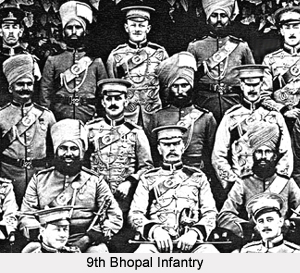 The 9th Bhopal Infantry was an erstwhile infantry regiment of the British Army in India. The unit was a part of the Bengal Army of Bengal Presidency. It was administered by the British East India Company until the Great Revolt or Sepoy Mutiny of 1857. The Bengal Army was amongst the 3 main Presidency Armies in British India. The 9th Bhopal Infantry regiment remained in active military service from the year 1859 till 1922. The battalion was re-designated as 4th Battalion (Bhopal) 16th Punjab Regiment in the year 1922. The Nawab of Bhopal acted as the Colonel-in-Chief of the infantry regiment.
The 9th Bhopal Infantry was an erstwhile infantry regiment of the British Army in India. The unit was a part of the Bengal Army of Bengal Presidency. It was administered by the British East India Company until the Great Revolt or Sepoy Mutiny of 1857. The Bengal Army was amongst the 3 main Presidency Armies in British India. The 9th Bhopal Infantry regiment remained in active military service from the year 1859 till 1922. The battalion was re-designated as 4th Battalion (Bhopal) 16th Punjab Regiment in the year 1922. The Nawab of Bhopal acted as the Colonel-in-Chief of the infantry regiment.
History of 9th Bhopal Infantry
The 9th Bhopal Infantry was originally raised by the Princely State of Bhopal as a combined army of cavalry and infantry in 1818 at Sehore. It was formed for providing military service with the East India Company. The unit was titled as the Bhopal Contingent and was initially engaged in maintaining peace in the uncontrollable regions of Central India. After the culmination of the Indian Rebellion of 1857, the contingent was re-structured and reformed as the Bhopal Levy by Lieutenant Colonel James Travers, VC, in the year 1859. The military unit was later renamed as the Bhopal Battalion in 1865.
Military Operations of 9th Bhopal Infantry
The 4th Battalion (Bhopal) 16th Punjab Regiment took part in several battles and conquests under the British Indian Army. The troops fought in the Second Afghan War in 1878 and functioned on the Line of Communication. After Lord Kitchener re-organised the entire British Indian Army in the year 1903, the designation of the Bhopal Battalion was modified to the 9th Bhopal Infantry. The unit served during the First World War and was sent to France in the year 1914. The troops also took part in the Battle of Neuve Chapelle, the Battle of Festubert, the Battle of Givenchy and the Second Ypres Battle.
The 9th Bhopal Infantry was stationed in Mesopotamia in 1915 and fought a fierce battle on the Tigris Front. Three more battalions of the infantry regiment were formed during the Great War, which were eventually dissolved.
Development of 9th Bhopal Infantry
In the year 1922, the British Government of India undertook a major restructuring in the British Indian Army. As a result, several single infantry regiments were amalgamated together in order to raise multi battalion large infantry groups that consisted of 4 to 6 battalions. The 9th Bhopal Infantry was merged with the 30th Punjabis, the 31st Punjabis, the 33rd Punjabis and the 46th Punjabis to form the 16th Punjab Regiment. The battalion was titled as the 4th Battalion (Bhopal) 16th Punjab Regiment. In the Second World War, the army unit fought in Italy, North Africa and the Italian East Africa.
Designations of 9th Bhopal Infantry
The 9th Bhopal Infantry regiment of the British Indian Army occupied a number of designations through out its service. These are mentioned below-
* The Bhopal Contingent - 1818
* Bhopal Levy - 1859
* Bhopal Battalion - 1865
* 9th Bhopal Infantry - 1903
* 1st Battalion 9th Bhopal Infantry - 1917
* 4th Battalion (Bhopal) 16th Punjab Regiment - 1922



















